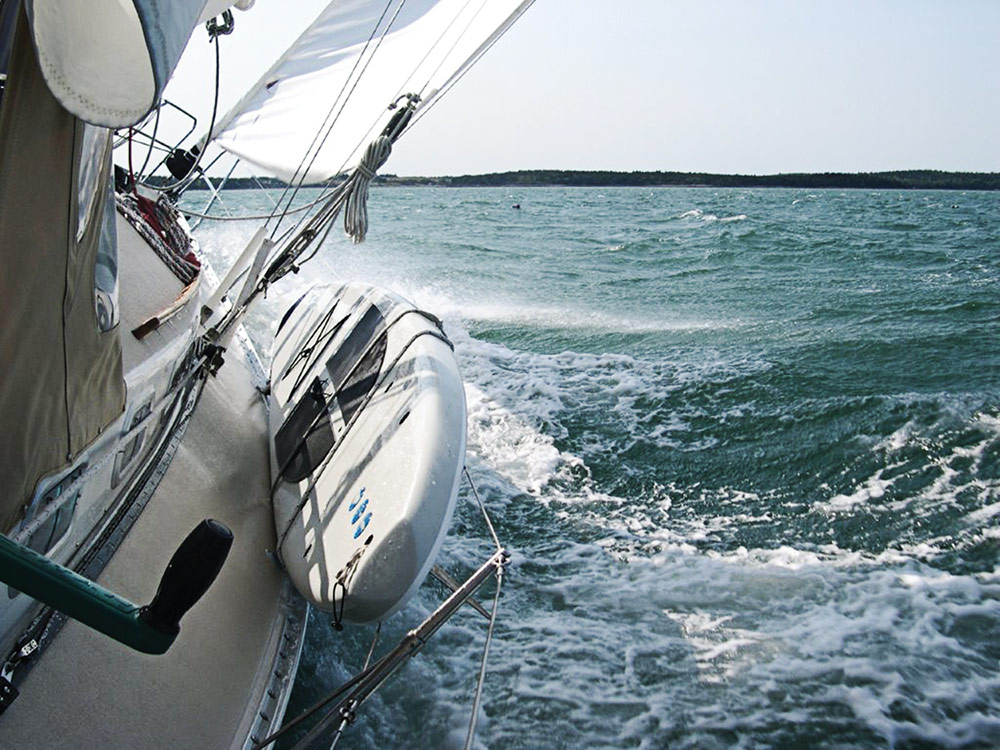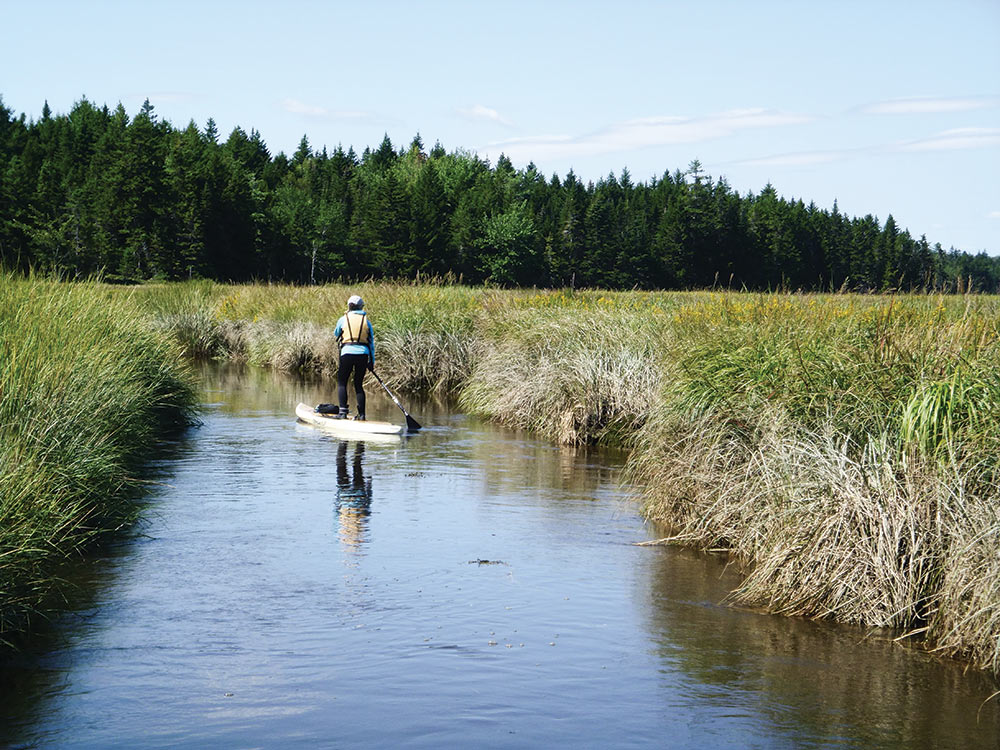
How can one possibly enhance Maine’s magnificent coastal cruising? Our answer: carry stand-up paddleboards. Indeed, the explorations and exercise they provide are high points of our sailing journeys. We would not want to carry our rigid boards offshore, but in near-shore conditions they travel without difficulty, lashed to the lifelines outboard of our Finngulf 391 West Wind‘s inboard chainplates. We still love rowing and exploring with the wonderful wooden Maine-built pea pod we tow, but nowadays, we more often find adventure on the paddleboards when the water is calm.
A memorable paddle up the Englishman River, a lovely estuary draining into Englishman Bay just east of Roque Island, exemplifies the fun and the connection to nature we enjoy. The anchorage off the river’s mouth is exposed, but we saw our opportunity on a sunny early September day with only light southeasterlies forecast. We slid the boards over the side and were off. We had been into the river once before by pea pod and knew the importance of playing the tidal current, which sluices through the entrance under a road bridge at considerable velocity. With the pea pod, timing our entry and exit to the tidal conditions had been crucial, but with paddleboards, there would have been the option of carrying them across the road and relaunching inside the bridge, if necessary. This day, though, we entered with a fair current a couple of hours before high tide. Once through the bridge, the current velocity was less but still sufficient to give a welcome boost.
We were soon past a handful of houses and into the river’s wild stretches. A forest of spruce and fir fringed the marsh grasses, and in the wide middle of the waterway, the rising tide rapidly covered expansive flats. In many places, we were slightly early in our timing, the fins of our paddleboards gouging the mud. Where necessary, we dropped to our knees and moved our weight well forward to reduce the fins’ draft, sometimes having to pole with the paddles to push our way to deeper water. Our timing of the tide was good enough that we never had to hop off and wade, and soon we had no worries as to water depth.
September held the promise of bird migration season. In our belt packs we had small 10-power binoculars and a waterproof camera for spotting and recording. Enthralling was the sheer number of yellowlegs and smaller sandpipers along the winding channel, as well as herons, Canada geese, the occasional eagle and other birds that one would expect in such an area. It was an education in how important these estuarine stopovers are along the eastern Maine coast.
Eventually, the channel narrowed and grew ever more winding between banks covered by marsh grass nearly as tall as us. Within the curves were pools in the grass with water levels higher than the channel except at the top of the tide. From some, we flushed black ducks.
As the tide turned, we also turned to ride the current down and out of the river before water depths dropped too much. We clambered back aboard West Wind and pulled the boards on deck, exhilarated by yet another wonderful cruising experience.
Our boards are relatively high-performance fiberglass touring boards. They have a shallow-V cross section and pointed bow with upward sweep. Ben’s is 14 feet long, Dianna’s 12½ feet. The weight of each is just over 30 pounds. We recognize the advantages of inflatable boards for carrying aboard a cruising boat, and for voyages farther afield we might choose them. For short sails in coastal waters, though, we prefer the livelier performance of our rigid boards — and not having to inflate and deflate them between excursions. Our other equipment consists of carbon-fiber paddles, leashes tethering the boards to our ankles, life jackets and kayak booties.
For clothing, we often just wear whatever we have been wearing on deck: bathing suits or jeans, T-shirts or fleece jackets, whatever the weather calls for. Knock on wood, we very rarely fall in. (In winter, paddleboarding from the beach while West Wind rests in a Maine shed, we wear drysuits.) Our staying upright largely results from confining our paddleboarding to relatively calm days with minimal waves and keeping a close eye on depth in shallow water. Lobster-boat wakes can be a particular hazard in Maine. If they look too big for us to remain standing and paddle through with the bow into the waves, we drop to our knees.
Launching and retrieving the boards is easy on West Wind. Our lifeline gates are well aft and wide. The toe rail is aluminum, much better than a varnished wooden toe rail at tolerating sliding the boards over it. For a wooden rail, however, it would not be hard to make a padded protective piece over which boards could slide.
There are two disadvantages, neither serious, that we find in having paddleboards on deck while cruising coastal waters. We lash them far enough aft so that visibility forward is not affected. Depending on the helmsman’s position, whether standing or sitting and whether amidships, to windward or leeward, the boards can interfere with visibility in the sector from about 45 degrees off the bow to nearly amidships. Just as a helmsman needs to peer around a low-cut jib that restricts visibility, so he or she needs to shift position and look over the board frequently if dangers may be obscured. The second effect of having the boards on deck is that their windage can increase the boat’s blowing back and forth at anchor. Generally, this is no problem, but if high winds are forecast, we sometimes move the boards aft alongside the cockpit to get the windage aft and thereby steady the boat.

Getting adequate exercise while cruising is crucial to us, for both our physical and mental health. The Maine coast is blessed with an array of lands with wonderful trails open to the public, including mainland and island properties of Acadia National Park, Coastal Islands National Wildlife Refuge, the state park system, Maine Coast Heritage Trust, the Nature Conservancy and local land trusts. We anchor off and enjoy the hikes through forests and grassy meadows and along rocky shorelines. Rowing our pea pod has been another superb way to have a workout, discovering nooks and crannies in innumerable bays and archipelagos. And then we added paddleboarding. Like cross-country skiing and swimming, it provides low-impact, full-body exercise, and is especially excellent for the body’s core.
For Dianna, loving to break a good sweat, paddling hard often replaces or augments running. One year, frequent paddling once greatly speeded her recovery from a broken ankle and knee.
The fact that paddling brings us so close to nature, as in our venture into the Englishman River, does as much good for our psyche as the balancing and the pulling on the paddle does for our muscles. The scenery and the birds are a constant presence. Paddling also draws one to what is under the water. Standing 5 to 6 feet above the surface of clear water enables a very good view of what is below — rockweed, eelgrass, crabs, starfish, sea urchins, sand dollars and a host of other forms of marine life. In tropical waters, we have done a great deal of snorkeling. Paddleboarding provides a viewing experience reminiscent of that. Carrying a mask and snorkel on the paddleboard and going into the water occasionally, even in Maine, is an enjoyable option in warm weather.
One morning brought three porpoises streaming along to cross Dianna’s wake and dive close under the board. A different day saw her slip off her board to swim with them as they chased mackerel.
Seals, curious creatures, often pop their whiskery snouts up to watch us paddle by. One morning brought three porpoises streaming along to cross Dianna’s wake and dive close under the board. A different day saw her slip off her board to swim with them as they chased mackerel. River otters are other mammals of coastal Maine waters we’ve encountered on rare but exciting occasions.
On stand-up paddleboards we have closely explored the best of Maine’s coastal sailing destinations, discovering jewels above and below the water. Paddling has added a yet more intimate connection to this magnificent coast. We return from our cruising feeling more fit physically and mentally, bonded with the coastal ecosystem that sustains us.
Ben and Dianna Emory are longtime sailors from Salisbury Cove and Brooklin, Maine. Each has a book being published by Seapoint Books in May 2018. Ben has written Sailor for the Wild — on Maine, Conservation and Boats. Dianna has written Bonding with Nature — Responding to Life’s Challenges and the Aging Process.








